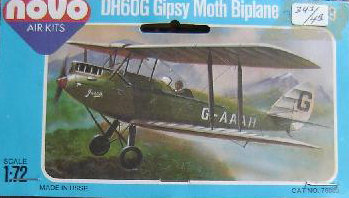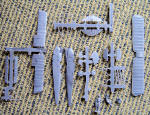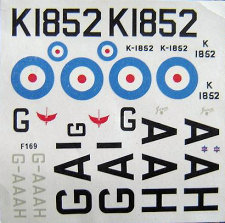
Novo/Frog 1/72 DH.60G Gypsy Moth
| KIT: | Novo/Frog 1/72 DH.60G Gypsy Moth |
| KIT #: | F 189 |
| PRICE: | $ |
| DECALS: | Two options |
| REVIEWER: | Zac Yates |
| NOTES: |

| HISTORY |
The de Havilland DH.60, colloquially known as Moth or Gipsy Moth, effectively kicked off the English aero club phenomenon of the late 1920s. Conceived by Geoffrey de Havilland as an aeroplane anyone could have in one’s garage, the light little two-seater was built in the thousands, and several dozen still fly today. You could travel to almost any town, city or village in the British Isles in this time and watch the pretty little biplanes flit about hither and yon. Freshly mown lawns, glimmering Rolls-Royces and Bentleys around the clubhouse, and the dying crackles of the Gipsy Major engine shutting down, the polished mahogany prop spinning to a stop….
The Moth was also used by a range of famous trailblazers in the so-called “Golden Age” of aviation, including such names as Amy Johnson and New Zealander Jean Batten. Miss Johnson flew her Moth, named “Jason”, from England to Australia in 1930, and Miss Batten did the same (later shipping the aircraft to New Zealand for a tour of that country) in a shorter amount of time. At the outbreak of the Second World War most surviving Moths were either placed in storage or impressed into military service, and what few remained after the cessation of hostilities became highly prized collector’s items. When they do become available on the market, the formerly humble DH.60 often reaches a premium price – mind you, if I wanted to experience the true aero club atmosphere of the 30s, I’d be quite glad to pay top dollar. In fact, I know a collector with a rather nice Moth for sale….oh for a larger bank balance!
| THE KIT |
 Until the day I finally hand over the cheque for
my very own 1:1 DH.60, this gem of a kit will more than suffice. I believe it
was originally issued by FROG, but my copy is proudly emblazoned with NOVO
logos. Mine was in the classic plastic bag with header card, featuring “box-art”
of G-AAAH (the aforementioned “Jason” of UK-Oz fame) on the front and painting
and decal placement instructions for both decal options.
Until the day I finally hand over the cheque for
my very own 1:1 DH.60, this gem of a kit will more than suffice. I believe it
was originally issued by FROG, but my copy is proudly emblazoned with NOVO
logos. Mine was in the classic plastic bag with header card, featuring “box-art”
of G-AAAH (the aforementioned “Jason” of UK-Oz fame) on the front and painting
and decal placement instructions for both decal options.
One folded sheet of newsprint forms the instructions, with nine clear steps to follow. On the reverse are a potted history of the type as well as a very cool addition, “10 Top Model Tips” – using tweezers for small parts, painting whilst on the sprue etc etc. Nice to see a model company helping out the modelling public!
The kit comes with two decal options – G-AAAH, the green and silver machine owned and flown by Amy Johnson, and an all-silver Moth of 601 (County of London) Squadron Auxiliary Air Force. On my example they were in less than perfect condition due to their age, but colouring looked spot on.
The kit itself
consists of 35 parts in a fairly soft dark grey, with a small amount of flash on
the trailing edges of the mainplanes (three parts – one-piece upper and two
separate lower) and some rather nasty ejector pin marks on the inside of the
two-piece tailplane and vertical tail. Separate control surfaces are included,
but as I haven’t yet dry-fitted the parts I can’t comment
 either way on how good/bad they
look once in place. No clear parts are included, but for the very keen or expert
modeller it shouldn’t be too hard to make your own windscreen/s.
either way on how good/bad they
look once in place. No clear parts are included, but for the very keen or expert
modeller it shouldn’t be too hard to make your own windscreen/s.
Accuracy seems all right – I spend my days around the comparatively more modern Tiger Moth, but looking at pictures of DH.60s it seems good – but one glaring fault is present in the kit: the distinctive DH W-shaped undercarriage strut (as shown in the box art) is replaced by a single straight-through axle. However, such a small part is easy enough to scratchbuild or poach from a Tiger kit. The box art shows Amy’s machine as it was on the England-Australia trip, with the front cockpit faired over, but no instructions or parts are included to allow you to represent this. Funny, as only one seat is included for the cockpit.
A nice touch is a slightly larger scale figure of Amy in her flying gear, so that you can build a small diorama of her before/after her record-making flight.
| CONCLUSIONS |
All in all this is a very nice little kit of a magnificent aircraft which, as with most (if not all) GA machines is one of precious few represented in kit form. I’m fairly sure it’s no longer in production anywhere, which is a shame, but fingers crossed it’s only a matter of time. Until one of the big manufacturers sees the potential in these old kits….ie, I’ll buy at least one….you’ll have to remain content scouring eBay and estate sales!
Kit courtesy of the eternally-generous Tony “rotorheadTX” Morgan.
November 2007
If you would like your product reviewed fairly and quickly, please contact me or see other details in the Note to Contributors.